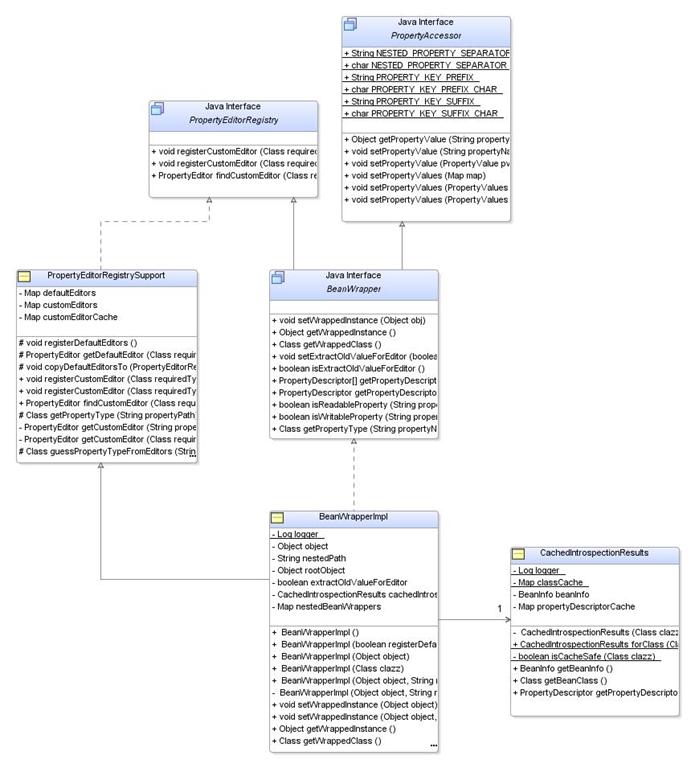org.springframework.beans簡單解讀
這個包的說明是說主要是包括用於操作JavaBean的類和介面,將被大部分spring包使用。在讀這個包的程式碼前,我特意將JavaBean規範讀了一遍。JavaBean規範不僅僅是getter、setter,定義了一個完整的輕量級元件模型,事件、方法、屬性、持久化等等支援均包含在內。JavaBean規範很明顯是學習Delphi的元件模型,sun希望通過它來形成一個java元件的市場,可惜結果不如人意,JavaBean在GUI方面並未形成一個類似delphi控制元件市場;隨著spring等輕量級框架的流行,而EJB重量級的元件模型被越來越多的人放棄,JavaBean反而在服務端模型方面佔據了主流
。廢話不提,這個包的核心介面和類就是BeanWrapper和BeanWrapperImpl,顧名思義,這個介面就是用於包裝JavaBean的行為,諸如設定和獲取屬性,設定屬性編輯器等(PropertyEditor)。看下這個包的核心類圖:

BeanWrapper介面繼承了PropertyAccessor(用於屬性訪問和設定)和PropertyEditorRegistry(屬性編輯器的獲取和設定),而BeanWrapperImpl除了實現BeanWrapper介面外還繼承自PropertyEditorRegistrySupport 類。在PropertyEditorRegistrySupport 類中可以看到spring預設設定的一系列自定義PropertyEditor。比如:
PropertyEditor的概念就是屬性編輯器,或者說屬性轉換器,比如我們在spring的配置檔案中設定某個bean的class,這是一個字串,怎麼轉換為一個Class物件呢?通過上面註冊的ClassEditor,看看這個類是怎麼實現的:
因為快取使用的key是bean的Class物件(以保證唯一性),因此在應用存在多個class loaders的時候,為了保證垃圾收集的進行,不出現記憶體洩露而採用WeakHashMap,為了理解這一點,我用JProfiler測試了自定義ClassLoader情況下,記憶體堆的使用情況,從快照上看。在使用HashMap的情況下,因為測試的bean的Class物件被載入它的ClassLoader以及java.beans.BeanInfo,java.beans.PropertyDescriptor,java.lang.reflect.Method這四個物件強引用,而導致不可回收。而在使用WeakHashMap時,判斷當載入bean的ClassLoader和載入CachedIntrospectionResults的ClassLoader是不同的時候,使用弱引用包裝快取物件,保證能被回收。請看:
不知道我的理解是否有誤,如果有誤,請不吝指出,謝謝。


BeanWrapper介面繼承了PropertyAccessor(用於屬性訪問和設定)和PropertyEditorRegistry(屬性編輯器的獲取和設定),而BeanWrapperImpl除了實現BeanWrapper介面外還繼承自PropertyEditorRegistrySupport 類。在PropertyEditorRegistrySupport 類中可以看到spring預設設定的一系列自定義PropertyEditor。比如:
protected void registerDefaultEditors() {
this.defaultEditors = new HashMap(32);
// Simple editors, without parameterization capabilities.
// The JDK does not contain a default editor for any of these target types.
this.defaultEditors.put(Class.class, new ClassEditor());
this.defaultEditors.put(File.class, new FileEditor());
this.defaultEditors.put(InputStream.class, new InputStreamEditor());
this.defaultEditors.put(Locale.class, new LocaleEditor());
this.defaultEditors.put(Properties.class, new PropertiesEditor());
this.defaultEditors.put(Resource[].class, new ResourceArrayPropertyEditor());
this.defaultEditors.put(String[].class, new StringArrayPropertyEditor());
this.defaultEditors.put(URL.class, new URLEditor());
。。。。。。。
this.defaultEditors = new HashMap(32);
// Simple editors, without parameterization capabilities.
// The JDK does not contain a default editor for any of these target types.
this.defaultEditors.put(Class.class, new ClassEditor());
this.defaultEditors.put(File.class, new FileEditor());
this.defaultEditors.put(InputStream.class, new InputStreamEditor());
this.defaultEditors.put(Locale.class, new LocaleEditor());
this.defaultEditors.put(Properties.class, new PropertiesEditor());
this.defaultEditors.put(Resource[].class, new ResourceArrayPropertyEditor());
this.defaultEditors.put(String[].class, new StringArrayPropertyEditor());
this.defaultEditors.put(URL.class, new URLEditor());
。。。。。。。
PropertyEditor的概念就是屬性編輯器,或者說屬性轉換器,比如我們在spring的配置檔案中設定某個bean的class,這是一個字串,怎麼轉換為一個Class物件呢?通過上面註冊的ClassEditor,看看這個類是怎麼實現的:
public class ClassEditor extends PropertyEditorSupport {
private final ClassLoader classLoader;
/**
* Create a default ClassEditor, using the given ClassLoader.
* @param classLoader the ClassLoader to use
* (or <code>null</code> for the thread context ClassLoader)
*/
public ClassEditor(ClassLoader classLoader) {
this.classLoader =
(classLoader != null ? classLoader : Thread.currentThread().getContextClassLoader());
}
public void setAsText(String text) throws IllegalArgumentException {
if (StringUtils.hasText(text)) {
try {
//呼叫輔助類,得到Class物件
setValue(ClassUtils.forName(text.trim(), this.classLoader));
}
catch (ClassNotFoundException ex) {
throw new IllegalArgumentException("Class not found: " + ex.getMessage());
}
}
else {
setValue(null);
}
}
public String getAsText() {
Class clazz = (Class) getValue();
if (clazz == null) {
return "";
}
if (clazz.isArray()) {
return clazz.getComponentType().getName() + ClassUtils.ARRAY_SUFFIX;
}
else {
return clazz.getName();
}
}
}
程式碼已經解釋了一切,繼承javabean的PropertyEditorSupport,自己實現轉換即可。這個包另外就是定義了一個完整的異常體系,值的我們參考。另外一個值的注意的地方是CachedIntrospectionResults類的實現,這個類使用了單例模式,它的作用在於快取JavaBean反省(Introspect)得到的資訊,因為每次使用Introspector對獲取JavaBean資訊是個不小的效能開支。快取使用的是WeakHashMap,而不是HashMap,看看spring的解釋:private final ClassLoader classLoader;
/**
* Create a default ClassEditor, using the given ClassLoader.
* @param classLoader the ClassLoader to use
* (or <code>null</code> for the thread context ClassLoader)
*/
public ClassEditor(ClassLoader classLoader) {
this.classLoader =
(classLoader != null ? classLoader : Thread.currentThread().getContextClassLoader());
}
public void setAsText(String text) throws IllegalArgumentException {
if (StringUtils.hasText(text)) {
try {
//呼叫輔助類,得到Class物件
setValue(ClassUtils.forName(text.trim(), this.classLoader));
}
catch (ClassNotFoundException ex) {
throw new IllegalArgumentException("Class not found: " + ex.getMessage());
}
}
else {
setValue(null);
}
}
public String getAsText() {
Class clazz = (Class) getValue();
if (clazz == null) {
return "";
}
if (clazz.isArray()) {
return clazz.getComponentType().getName() + ClassUtils.ARRAY_SUFFIX;
}
else {
return clazz.getName();
}
}
}
/**
* Map keyed by class containing CachedIntrospectionResults.
* Needs to be a WeakHashMap with WeakReferences as values to allow
* for proper garbage collection in case of multiple class loaders.
*/
private static final Map classCache = Collections.synchronizedMap(new WeakHashMap());
* Map keyed by class containing CachedIntrospectionResults.
* Needs to be a WeakHashMap with WeakReferences as values to allow
* for proper garbage collection in case of multiple class loaders.
*/
private static final Map classCache = Collections.synchronizedMap(new WeakHashMap());
因為快取使用的key是bean的Class物件(以保證唯一性),因此在應用存在多個class loaders的時候,為了保證垃圾收集的進行,不出現記憶體洩露而採用WeakHashMap,為了理解這一點,我用JProfiler測試了自定義ClassLoader情況下,記憶體堆的使用情況,從快照上看。在使用HashMap的情況下,因為測試的bean的Class物件被載入它的ClassLoader以及java.beans.BeanInfo,java.beans.PropertyDescriptor,java.lang.reflect.Method這四個物件強引用,而導致不可回收。而在使用WeakHashMap時,判斷當載入bean的ClassLoader和載入CachedIntrospectionResults的ClassLoader是不同的時候,使用弱引用包裝快取物件,保證能被回收。請看:
private static boolean isCacheSafe(Class clazz) {
//CachedIntrospectionResults的ClassLoader
ClassLoader cur = CachedIntrospectionResults.class.getClassLoader();
//載入bean的ClassLoader
ClassLoader target = clazz.getClassLoader();
if (target == null || cur == target) {
return true;
}
while (cur != null) {
cur = cur.getParent();
if (cur == target) {
return true;
}
}
return false;
}
public static CachedIntrospectionResults forClass(Class beanClass) throws BeansException {


boolean cacheSafe = isCacheSafe(beanClass);
if (cacheSafe) {
classCache.put(beanClass, results);
}
else {
//弱引用
classCache.put(beanClass, new WeakReference(results));
}


//CachedIntrospectionResults的ClassLoader
ClassLoader cur = CachedIntrospectionResults.class.getClassLoader();
//載入bean的ClassLoader
ClassLoader target = clazz.getClassLoader();
if (target == null || cur == target) {
return true;
}
while (cur != null) {
cur = cur.getParent();
if (cur == target) {
return true;
}
}
return false;
}
public static CachedIntrospectionResults forClass(Class beanClass) throws BeansException {


boolean cacheSafe = isCacheSafe(beanClass);
if (cacheSafe) {
classCache.put(beanClass, results);
}
else {
//弱引用
classCache.put(beanClass, new WeakReference(results));
}


不知道我的理解是否有誤,如果有誤,請不吝指出,謝謝。
相關文章
- Flutter 極簡 App 程式碼簡單解讀FlutterAPP
- golang - base64簡單解讀Golang
- redux原始碼解讀(簡單易懂版)Redux原始碼
- Mybatis原始碼簡單解讀----構建MyBatis原始碼
- Retrofit原始碼解讀(一)--Retrofit簡單流程原始碼
- LinkedHashMap,原始碼解讀就是這麼簡單HashMap原始碼
- 簡單易懂的雙向資料繫結解讀
- 《劍與遠征》設計思路解讀:“掛機”“簡單”與“單機”
- 簡單易懂的Vue資料繫結原始碼解讀Vue原始碼
- 解讀並實現一個簡單的koa-router
- Rancher 2.5特性解讀丨更簡單友好的API和DashboardAPI
- 《圖解HTTP》讀書筆記二:簡單的 HTTP 協議圖解HTTP筆記協議
- css對於小數尺寸值的解讀簡單介紹CSS
- 簡單聊聊mysql的髒讀、不可重複讀MySql
- easypoi 讀取 Excel 簡單應用Excel
- iOS 簡單資料的讀寫iOS
- WebSocket 簡單瞭解Web
- JWT簡單瞭解JWT
- 簡單瞭解procmailAI
- PostgreSQL 原始碼解讀(249)- 實現簡單的鉤子函式SQL原始碼函式
- 簡單解讀AISWare AIDB亞信資料庫產品特性AI資料庫
- WiNet智慧網路解決方案解讀 讓網路運維更簡單運維
- linux讀寫檔案 簡單版Linux
- javascript讀寫cookie操作簡單介紹JavaScriptCookie
- 《明解c語言:入門篇》閱讀後的簡單評價C語言
- Airtest簡單上手講解AI
- Golang介面簡單瞭解Golang
- 多型 簡單講解多型
- 防火牆-簡單瞭解防火牆
- 簡單瞭解組策略
- 關鍵字: 讀取表單中最簡單的資料
- PostgreSQL 原始碼解讀(216)- 實現簡單的擴充套件函式SQL原始碼套件函式
- Vue2原始碼解讀(4) - 響應式原理及簡單實現Vue原始碼
- httprunner3原始碼解讀(1)簡單介紹原始碼模組內容HTTP原始碼
- 檔案讀寫網路IO簡單瞭解,同步IO和非同步IO非同步
- 讀《番茄工作法圖解:簡單易行的時間管理方法》有感圖解
- 資料讀取之邏輯讀簡單解析--關於BUFFER CACHE
- Python 簡單入門指北(試讀版)Python